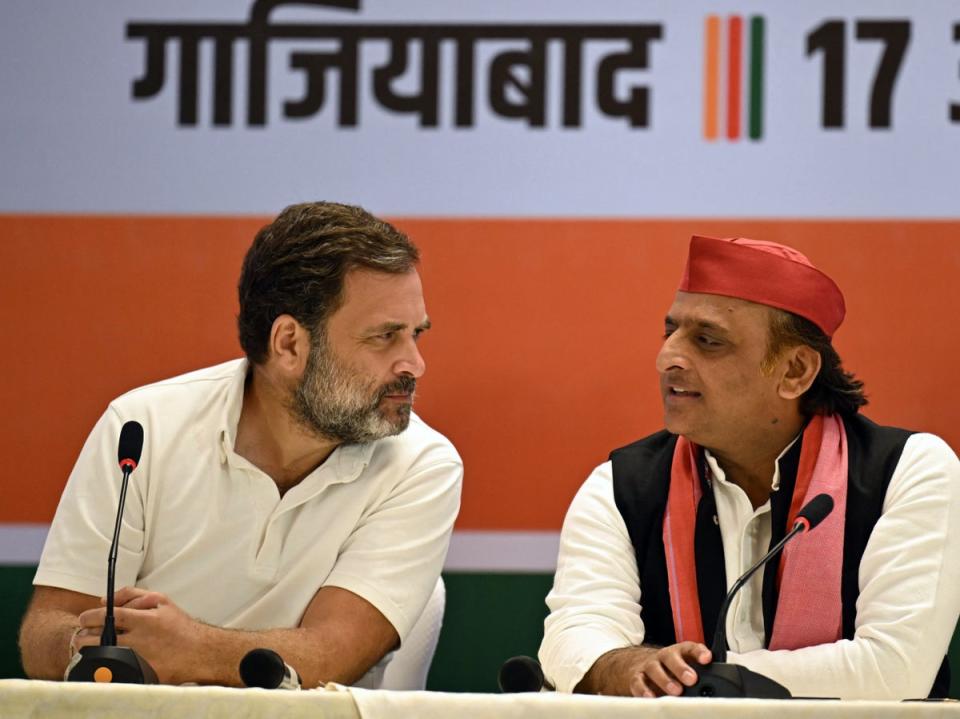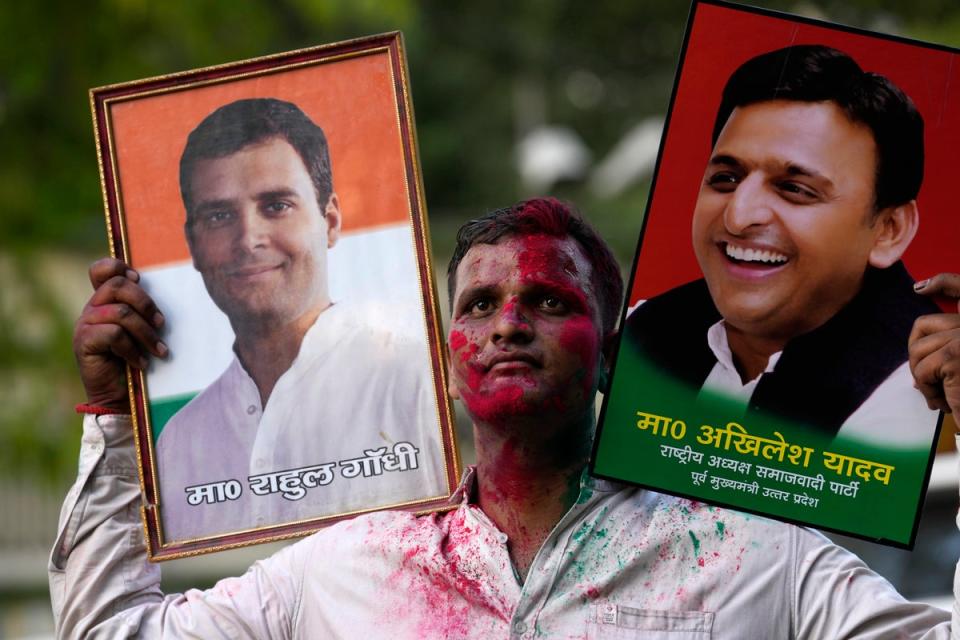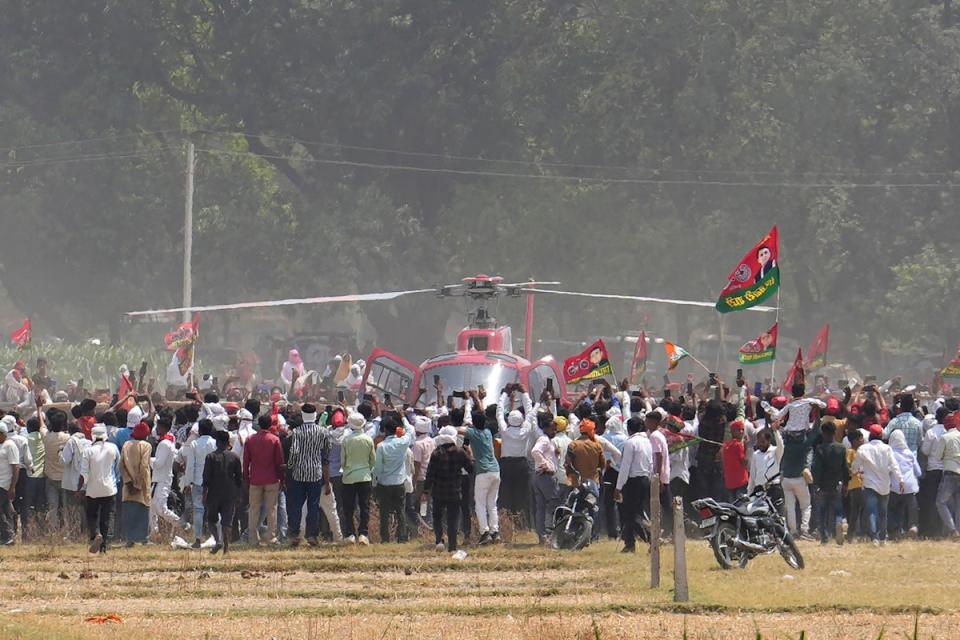Samajwadi Party: Regional player that delivered the most shocking defeat of Modi’s political career
Narendra Modi is set to stay on as India’s prime minister for a historic third term but with a much weaker mandate. His Bharatiya Janata Party lost its absolute parliamentary majority, defying exit polls, and must depend on mercurial allies to form the government. A big part of the reason was heavy losses in the heartland state of Uttar Pradesh, chiefly at the hands of the Samajwadi Party.
The BJP won a brute majority of 303 seats in the 543-member Lok Sabha, the lower house of parliament, in 2019 but managed only 240 this time around.
In Uttar Pradesh, the country’s most populous state which accounts for 80 seats, the party won 62 seats five years ago but was reduced to 33 in this election. The opposition INDIA bloc got 43 seats, with the Samajwadi Party taking 37, a seven-fold increase over the previous election.
Follow our live coverage on 2024 Indian election results.
A regional party with socialist roots
The Samajwadi Party was floated in 1992 by Mulayam Singh Yadav with the stated aim of “creating a socialist society that works on the principle of equality”.
Mr Yadav, whose political acumen earned him the sobriquet “Little Napoleon” from former prime minister Chaudhary Charan Singh, actively participated in the socialist movement during the 1950s, advocating for rights of farmers and the labour class, and was elected a legislator in Uttar Pradesh in 1967.
He became the state’s chief minister in 1989 and went on to serve three terms. He was also, briefly in the 1990s, the country’s defence minister.
A few years before his death in October 2022, Mr Yadav handed the reins of the Samajwadi Party to son Akhilesh Yadav, 50, who just dealt Mr Modi the heaviest blow of his political career.

How the party fared in Uttar Pradesh
The Samajwadi Party emerged from this election as the third largest parliamentary party after the BJP and the main opposition Congress party.
In the process, the party recorded its best performance in a national election since 2004 when it secured 35 seats.
It even wrested prestige seats from the BJP, most notably Faizabad where the Ayodhya Ram temple is located.
The construction of the temple on the ruins of a mediaeval mosque that was torn down by a Hindu mob in 1992, has been a core agenda of the BJP since its inception and Mr Modi consecrated the shrine in a grand ceremony in the run-up to the election.
The temple’s inauguration was seen as the BJP’s fulfilment of an old promise made to the Hindu majority and it was expected to yield an electoral dividend for the Hindu nationalist party in Uttar Pradesh. In the event it did not help even in Faizabad.
“Ayodhya was used for the politics of Bharatiya Janata Party and the people of Ayodhya were never addressed,” Apoorvanand, Delhi University professor and political analyst, told The Independent by way of an explanation.
“If you go back to 1992 and you look at the record of Ayodhya and Uttar Pradesh, you will see that the BJP was defeated even then.”
“People of Ayodhya were not interested in this dispute,” he argued. “People of Ayodhya were not fighting with each other. Outsiders invaded and Ayodhya suffered.”
Mr Apoorvanand said the people were “very very upset” with the BJP despite the temple’s inauguration early this year due to the acquisition of their lands for infrastructure projects such as wider roads and facilities for pilgrims and tourists.
“I received a call from a real estate dealer from Noida the day after the temple was consecrated, asking me if I was interested in buying land in Ayodhya,” he said, explaining how openly land acquired in the town was being sold to outsiders.
This fed the perception that the BJP’s projects in Ayodhya were more for show than to genuinely benefit the local population.

The Samajwadi Party also enabled its ally Congress to put up a strong fight in Mr Modi’s Varanasi constituency, cutting his margin of victory from nearly 480,000 votes in 2019 to just over 150,000.
In contrast, Rahul Gandhi, the main opposition leader from the Congress, won in the constituency of Rae Bareli by nearly 390,000 votes.
In Kannauj, Akhilesh Yadav himself won by a hefty margin against the BJP’s Subrat Pathak.
“Modi has seemingly lost his aura of electoral invincibility,” Michael Kugelman, director of South Asia Institute at Wilson Center, was quoted as saying by Reuters.
“This is a leader who has repeatedly bounced back from political and policy setbacks and retained large public mandates. With the results we’re seeing, that narrative of resilience has been dealt a big blow.”
How the party scripted its success
Samajwadi Party has traditionally banked for support of the Muslim minority and the Hindu Yadav community of its leadership.
The Yadavs are counted among the Other Backward Classes, or OBCs, a vast collection of caste groups which occupy the lower-middle and lower rungs on the Hindu caste hierarchy.
In the past five years, Mr Apooranand told The Independent, the party strategically broadened its coalition by courting non-Yadav OBCs and Dalits – formerly “Untouchables”, the lowest rung in the caste system.
At the same time, Akhilesh Yadav galvanised the party’s workers by focusing on issues of social justice and equitable representation, organising effective campaigns, and ensuring strategic ticket distribution to candidates from diverse backgrounds.
“The party gave tickets to candidates from varied backgrounds that wanted representation,” Mr Apooranand said.

Another factor was that the marginalised Dalit community feared for their rights under the BJP and they “moved to the Samajwadi Party”.
The Dalits traditionally voted for the Bahujan Samaj Party, a regional rival of the Samajwadi Party in Uttar Pradesh that championed the interests of the most marginalised communities. But the party led by former chief minister Mayawati is a shadow of its former self.
The Dalits went to the Samajwadi Party, Mr Apooranand argued, because “they saw that Mayawati wasn’t interested in a real fight with the BJP”.
Ms Mayawati’s party lost power in Uttar Pradesh to the Samajwadi Party in 2012 and failed to win a single seat in the 2014 national election. It made a recovery in 2019 after allying with the Samajwadi Party and secured 10 seats. The party went it alone this time and came up empty handed.
Mr Yadav reportedly instructed his party’s cadre not to criticise the Bahujan Samaj Party and Ms Mayawati even after she ended their alliance in 2019.
Instead, alongside Mr Gandhi, he highlighted the concern that a big parliamentary majority for the BJP would enable it to amend the constitution to the detriment of marginalised communities, a message that resonated with the Dalit community.
He also demanded a caste census in the country arguing it would ensure each community received their due from the government according to their population.
The BJP has consistently rejected the demand, fearing it would cost it support among the privileged Hindu upper castes, who generally oppose reservation in public education and employment for the marginalised communities.
In effect, Mr Yadav sought to counter BJP’s Hindu nationalist rhetoric by focusing on social justice and fair representation.
He was helped along by a wave of anger among young people in Uttar Pradesh frustrated by a lack of jobs.
“There was hidden anger in the youth in UP,” Samajwadi Party leader Salim Sherwani told Hindustan Times. “There was no impact of the Ram temple despite attempts to whip it up, as is evident in the results.”
“Joblessness remains acute. Young men who were 20 years old in 2014 when Modi was sworn in for the first time are 30 today without any change in status. You may have the gift of the gab but delivery has to be on the ground.”

The Indian Express noted that disenchantment over the Modi government’s controversial short-term military service scheme, Agnipath, also contributed to Samajwadi Party’s resurgence in Uttar Pradesh.
The newspaper found that the scheme had few takers in cities like Bareilly, Badaun, Agra, Allahabad, Bhadohi, Rae Bareli and Amethi where military recruitment centres would usually be crowded with young men seeking jobs.
The cancellation of an exam for state police jobs after a paper leaked left 4,800,000 candidates frustrated and allowed the Samajwadi Party to launch a pointed attack on the ruling BJP.
The opposition bloc also benefited from the chemistry between Mr Yadav and Mr Gandhi. They held campaign rallies in nearly every seat of Uttar Pradesh and drew enormous crowds.
The man of the moment
Mr Yadav, a former chief minister of Uttar Pradesh, told India Today after the results were declared on Tuesday that the “aim of the Samajwadi Party was to stop the BJP and we succeeded”.
On his Instagram page, he denounced the “negative politics of division” and said that “the conscientious people of UP have once again shown the country a new path, a new hope.”
“This is a victory of harmony and positive politics.”
His supporters were overjoyed. “Jai Akhilesh, Jai Samajwadi,” one of them wrote, meaning “Hail Akhilesh, Hail Socialism”. Another declared: “Next PM, brother Akhilesh.”
Another said: “Akhilesh bhaiyya is back.”


